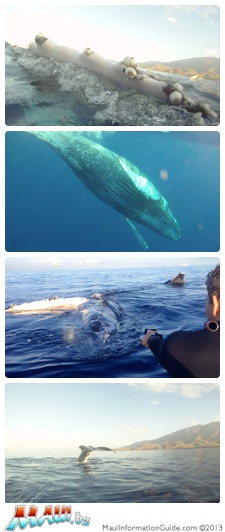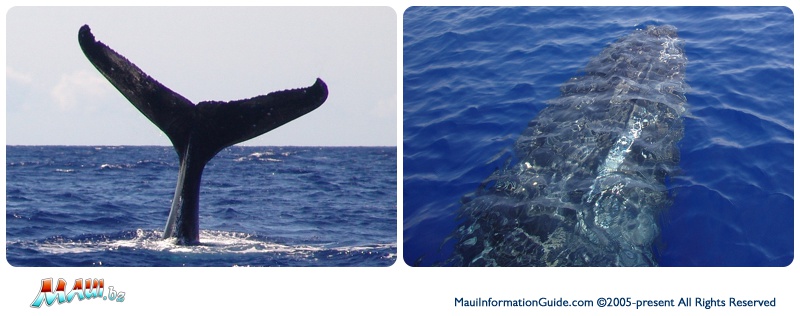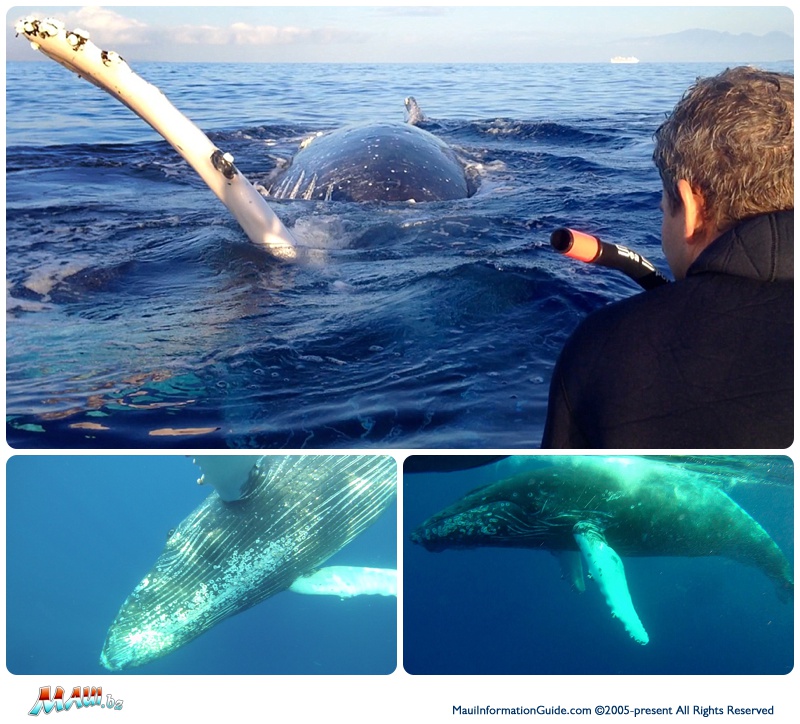Vacationers aren’t the only ones who flock to Hawaii to enjoy the warm, tropical waters each year.
 From December to May, an estimated 12,000 humpback whales, around 2/3 of the entire North Pacific humpback whale population, swim over 3,000 miles from the gulf of Alaska to Hawaii to breed, calve and nurse their young in the waters around Hawaii. Humpback whales, identifiable by the white markings on their underside and extraordinarily large flippers, usually 1/3 of their body length and the largest of any whale, can be seen throughout the islands and are treated with great respect as “aumakua”, or family guardians.
From December to May, an estimated 12,000 humpback whales, around 2/3 of the entire North Pacific humpback whale population, swim over 3,000 miles from the gulf of Alaska to Hawaii to breed, calve and nurse their young in the waters around Hawaii. Humpback whales, identifiable by the white markings on their underside and extraordinarily large flippers, usually 1/3 of their body length and the largest of any whale, can be seen throughout the islands and are treated with great respect as “aumakua”, or family guardians.
“Kohola”, or humpback whales, migrate from their summer feeding grounds to warmer winter breeding waters annually, eating only in the summer months and living off of their thick layer of blubber in the wintertime. Known as filter feeders, humpbacks feed on a mixture of krill, plankton and small fish and typically eat up to a ton of food per day.

Male humpback whales are known for their complex mating songs, which span an impressive eight octaves and can be heard up to 12 miles away, and are performed in order to communicate with other whales and attract potential mates. Female whales nurse their calves for almost a year and stay close with their young, who eat 100 pounds of their mother’s milk per day and learn to swim within 30 minutes of being born. It takes an average of 10 years for whales to be fully grown and 15 years for them to reach full maturity, weighing an average of 30 to 50 tons and reaching 48 to 63 feet in length, with females being slightly larger than male whales.

Humpbacks live together in pods of up to 20,000 whales, although typically only traveling together for a few days at most. Much like dolphins, humpback whales breathe voluntarily and sleep by shutting off half of their brain at a time. They can dive up to 700 feet and have a life expectancy of 45 to 50 years, although some research suggests they can live upwards of 90 years. They were first protected as an endangered species in 1966 and it’s estimated that only about 30% of their original population remains today, around 30,000 to 40,000 whales.
They can often be seen performing various water tricks, including using their tail fin, or fluke, to breach most of their body out of the water, spyhopping, or poking their head out of the water to look around, lobtailing, sticking their tail out of the water and slapping it back down on the surface, pec slaps, head lunges, and fluke-up dives, among others. It’s not known whether they breach to clean pests from their skin or do it just for fun, but either way, we enjoy it. Check out our close encounter with whales off the shore of Lahaina!
[youtube https://www.youtube.com/watch?v=Wp2LpeTzLzw]
One of the best places in the world to see these majestic creatures is the Auau Channel, a shallow area between West Maui, Lana’i and Molokai. February is Humpback Whale Awareness Month in Hawaii, so make sure to take one of the many amazing humpback whale tours offered every year or keep an eye out from the shore on your next visit to Maui.
[youtube https://www.youtube.com/watch?v=SN03rgGW2r4]
For more information and a comprehensive list of local whale watching tours, visit MauiWhaleWatchTours.com.
Photos by Natalie Brown, Sherrie Miller-Evans and Maui Information Guide.

